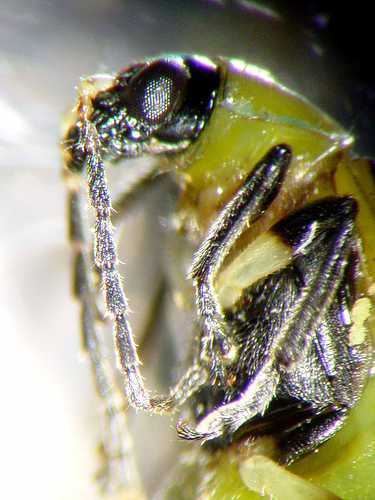 The corn rootworm.Photo: Jimmy SmithNow that 94 percent of the soy and 70 percent of the corn grown in the U.S. are genetically modified, Monsanto — one of the companies that dominates the GMO seed market — might look to some like it’s winning. But if we look a little closer, I’d say they’re holding on by a thread.
The corn rootworm.Photo: Jimmy SmithNow that 94 percent of the soy and 70 percent of the corn grown in the U.S. are genetically modified, Monsanto — one of the companies that dominates the GMO seed market — might look to some like it’s winning. But if we look a little closer, I’d say they’re holding on by a thread.
Their current success is due in large part to brilliant marketing. The company’s approach was both compelling — their products were sold as the key to making large-scale farming far simpler and more predictable — and aggressive: Monsanto made it virtually impossible for most farmers to find conventional seeds for sale in most parts of the country.
Despite promises of improved productivity, enhanced nutritional content, or extreme weather tolerance — none of which has ever come to market — Monsanto has only ever produced seeds with two genetically modified traits: either herbicide tolerance or pesticide production. And even those traits never lived up to the marketing hype.
But it now appears that the core traits themselves are failing. Over the last several years, so-called “superweeds” have grown resistant to the herbicide RoundUp, the companion product that’s made Monsanto’s herbicide-tolerant (aka RoundUp-Ready) corn, soy, and alfalfa so popular. Those crops were supposed to be the only plants that could withstand being sprayed by the chemical. Oops.
The superweed problem is so bad that farmers in some parts of the country are abandoning thousands of acres because the weeds are so out of control, or dousing the crops with ever more toxic (and expensive) combinations of other herbicides. Thankfully, it’s an issue that’s getting more and more media attention.
And now Monsanto’s other flagship product line, the pesticide-producing “Bt crops,” named for the pesticide they are genetically modified to emit, is in trouble.
Scientists have warned that insects would become resistant from the overuse of Bt crops, but Monsanto poo-pooed it. Even so, when the EPA first considered Bt crops for approval, agency scientists wanted a 50-percent buffer to prevent resistance (only half the acreage in any given field could be planted with Bt crops). Of course, if that demand stood, there is no way that Monsanto would ever have achieved their current market dominance.
Monsanto was so convinced (publicly at least) of their products’ immunity from, well, an immunity problem, that they pushed back hard and got the buffer zone reduced to 20 percent. The idea with a larger buffer was that any resistant bugs that arose would breed with the bugs feeding on the non-Bt crops nearby, and ecological balance would be preserved. So, by requiring a small buffer, EPA higher-ups were echoing Monsanto’s party line: Resistance isn’t a risk.
Sadly, even that 20-percent rule has been ignored by many farmers, with no fear of retribution from Monsanto for violating safety protocols, of course. After all, the smaller the buffer, the more of their profit-earning GMO seeds farmers were planting.
Yet it’s possible that the EPA is starting to push back against Monsanto’s handling of its Bt crops a little. In a new report [PDF] — unpublicized and buried deep in a government website — and analyzed in detail over at Mother Jones, the EPA confirms many anti-GMO activists’ deepest fears. The report “officially” found evidence that corn rootworms, a major pest for corngrowers, have grown resistant to Bt in several states; even worse, that resistance is strong enough that EPA scientists are insisting the company implement a “remedial action plan.” In addition, the report criticizes Monsanto for missing the rise of the rootworm resistance problem via its faulty monitoring system.
However, Tom Philpott at Mother Jones picks out the report’s key eyebrow-raiser:
Perhaps most devastatingly of all, EPA reveals that Monsanto has been receiving reports of possible resistance since 2004 — the year after the product’s release — when it got 21 such complaints nationwide. The number of reports ballooned to 94 in 2006 and has been hovering at around 100 per year since. And guess what? “Monsanto reported that none of their follow-up investigations resulted … in finding resistant populations [of rootworms].”
Naturally, Monsanto continues to deny the problem. In a recent blog post on its website responding to the EPA report, Monsanto again rewrote reality, claiming: “Scientific confirmation of corn rootworm resistance … has not been demonstrated.”
Of course, this peer-reviewed study, which provided just such confirmation, doesn’t count because … because Monsanto said so. So there.
Monsanto’s denial of reality in favor of its bottom line, while a practice now commonplace in corporate America, will have repercussions beyond industrial agriculture. Bt is also a key pesticide for organic agriculture; if resistance spreads, it’s possible that Bt will lose its effectiveness for organic farmers as well. We’re still far from that, thankfully.
Interestingly, this story has mainly been picked up by the business press concerned with the effect of this latest development on Monsanto’s stock price. Perhaps we should take the warning of stock traders as a good indicator that Monsanto may really be in trouble.
There is an obvious immediate solution here: Require farmers to plant larger buffers. It’s not at all clear that the EPA is prepared to go beyond posting a critical report on an obscure government website — but if they were, it would have the immediate effect of reducing the amount of Bt corn and soy farmers are growing. And that wouldn’t just be good for the bugs.



